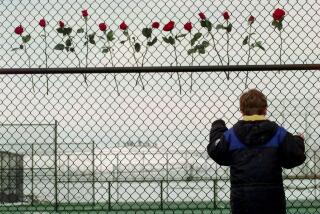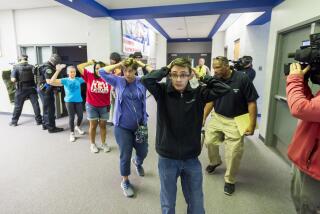L.A. schools react after Sandy Hook massacre
By all accounts, the grade school in Newtown, Conn., had strict security procedures, tightened earlier this year in an effort to make sure the campus was as safe as possible. A letter had been sent out to all parents, alerting them to the upgrade.
But on Friday, it was all quickly defeated when a gunman opened fire inside Sandy Hook Elementary in the deadliest campus shooting since the Virginia Tech rampage in 2007. In all, 26 people were fatally shot at the school — 20 of them children — before the attacker killed himself.
In the wake of the carnage, school officials and experts said they expect — and understand — that a deluge of concerns and questions from parents lies ahead. They also remained firm that despite episodes of extreme violence such as the incident in Connecticut, campuses are generally safe and remain a haven for students.
“School remains one of the safest places for children to be,” said Long Beach Unified Supt. Christopher J. Steinhauser.
In the years since the 1999 mass shooting at Columbine High School in Colorado, schools nationwide have bolstered security measures. The biggest trends have been placing more police officers — rather than security guards — on campus, installing metal detectors and adding sophisticated locking systems on buildings.
Schools have also worked on developing robust emergency plans and have trained educators on how to respond to crises on campus, said Sonayia Shepherd, an analyst at Safe Havens International, a nonprofit that advises thousands of K-12 schools on safety and security.
Elementary schools in particular have focused heavily on crisis management, Shepherd said. “They understand that they have the most vulnerable populations — they have the young kids,” she said.
At the grade school in Newtown, visitors are required to ring a doorbell to alert office staff, who have a video monitor for the front entrance. The entrance is locked at 9:30 a.m., at which point visitors must go to the office and sign in with identification.
But the gunman at the grade school — identified by authorities as 20-year-old Adam Lanza — was the son of a woman who worked at Sandy Hook and allegedly opened fired after arguing with a school official. Authorities said Lanza killed his mother at home before driving to the campus and committed suicide after the massacre.
Security measures at schools across the nation vary widely, and some experts, such as Cleveland-based school security consultant Ken Trump, worry that attention to safety has diminished in the years since Columbine or has buckled under the weight of budget cuts.
At a typical L.A. Unified School, the first person a visitor would greet is a parent volunteer or part-time worker stationed just inside the main entrance. That person manages a sign-in sheet, issues a visitor’s pass and asks where the visitor is going. Sometimes, the gatekeeper will get permission from the office before allowing entry. At other times, the monitor will simply provide directions.
Yet in the minutes before and after school, it’s easier to walk onto campus in the crush of students.
Most school systems don’t employ their own police force, relying instead on local law enforcement.
L.A. Unified employs more than 200 police officers, but they are spread thin across more than 1,000 campuses and virtually never patrol elementary schools. Instead, they are trained to converge on a trouble spot when something happens. The district also employs unarmed security aides and relies on local law enforcement for assistance.
On Friday, the district’s police force and law enforcement partners increased patrols around campuses to ease fear and anxiety stemming from the shooting, the district said.
For students in L.A. Unified and many other districts, Friday marked the last day of classes before winter break, which creates special circumstances, said UC Berkeley Professor Frank Worrell, the director of the university’s School Psychology program.
“Many schools are closing [for the break], which means they may not have a chance to deal with the grieving process as a community. It’s hugely important for children and adults to express grief,” he said.
Desiree Manuel, principal at Huerta Elementary in Los Angeles, sent students home with a letter to parents and also put out an automated phone alert to families that the school is aware of the shooting and that parents could feel confident that all measures were being taken to keep children safe.
The template was quickly put together by the Partnership for Los Angeles Schools, a nonprofit that manages about 15 campuses in conjunction with the Los Angeles Unified School District.
“As you know, this sort of tragedy can be terribly upsetting to children,” the prepared message states. “… We encourage you to be alert to your child’s potential anxieties as a result of this terrible incident, and please do not hesitate to talk with your child about this shooting: Let them express their fears and concerns and gently reassure them that their school and environment are safe.”
At Huerta Elementary, the front gate is open only from 7:20 a.m. to 7:55 a.m. and under staff supervision. Afterward, all visitors must enter by the office, where they sign in and receive a visitor’s badge. A part-time security aide helps supervise the playground. As a new campus, Huerta also has a secure faculty garage with a video monitor.
In addition, Manuel invested in extra walkie-talkies for teachers in classrooms farthest from the office. They’ll be able to coordinate with each other even if phone lines and power go down.
The South L.A. school’s rituals include a lockdown drill. Students are taught to go to the safest, nearby, supervised room when the alarm sounds. And they also know a code phrase signifying that all is clear.
“We talk about safety every day,” Manuel said. Her goal is to make sure that “our school is the safest place in the community.”
More to Read
Start your day right
Sign up for Essential California for news, features and recommendations from the L.A. Times and beyond in your inbox six days a week.
You may occasionally receive promotional content from the Los Angeles Times.







